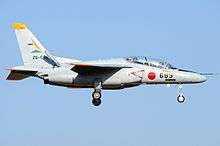Japan Air Self-Defense Force
The Japan Air Self-Defense Force (航空自衛隊, Kōkū Jieitai), JASDF, also referred to as the Japanese Air Force,[2] is the air warfare branch of the Japan Self-Defense Forces, responsible for the defense of Japanese airspace and for other aerospace operations.[3] The JASDF carries out combat air patrols around Japan, while also maintaining a network of ground and air early-warning radar systems. The branch also has an aerobatic team known as Blue Impulse and has provided air transport in UN peacekeeping missions.
| Japan Air Self-Defense Force | |
|---|---|
| 航空自衛隊 | |
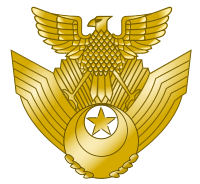 Japan Air Self-Defense Force emblem | |
| Founded | 1 July 1954[1] |
| Country | |
| Type | Air force |
| Role | Aerial warfare |
| Size | 50,324 personnel (2013)[1] 745 aircraft |
| Part of | |
| Garrison/HQ | Ichigaya, Shinjuku, Tokyo, Japan |
| Motto(s) | "Key to Defense, Ready Anytime!" |
| Website | www |
| Commanders | |
| Prime Minister of Japan | PM Shinzō Abe |
| Minister of Defense | Tarō Kōno |
| Chief of Staff, Joint Staff | General Kōji Yamazaki |
| Chief of the Air Staff | General Yoshinari Marumo |
| Insignia | |
| Roundel |  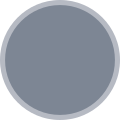 |
| Flag | 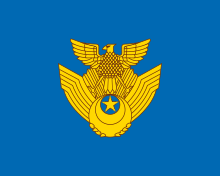 |
| Aircraft flown | |
| Electronic warfare | E-767, EC-1, E-2C/D, YS-11EA/EB |
| Fighter | F-15J/DJ, F-2A/B, F-35A, F-4EJ/EJ Kai |
| Helicopter | UH-60J, CH-47J (LR) |
| Trainer | T-7, T-400, T-4 |
| Transport | C-1, C-2, KC-767, C-130H, Boeing 777-300ER |
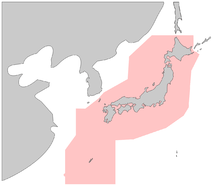
The JASDF had an estimated 50,000 personnel as of 2013, and as of 2020 operates about 740 aircraft, approximately 330 of them fighter aircraft.[4]
As early as Fiscal Year 2021, the service's name will change to the Japan Aerospace Self-Defense Force in recognition of the increasing importance of the space domain.[5]
History
Japan did not have a separate air force before and during World War II. Aviation operations were carried out by the Imperial Japanese Army Air Service and the Imperial Japanese Navy Air Service (Kōkūtai). Following World War II, the Imperial Japanese Army and Navy were disbanded in 1945. Article 9 of the United States–written 1947 constitution prevented Japan from having a regular military.
On 1 July 1954, the National Security Board was reorganized as the Defense Agency, and the National Security Force was reorganized afterwards as the Japan Ground Self-Defense Force (de facto post-war Japanese Army), the Coastal Safety Force was reorganized as the Japan Maritime Self-Defense Force (de facto post-war Japanese Navy) and the Japan Air Self-Defense Force (de facto post-war Japanese Air Force) was established as a new branch of JSDF. General Keizō Hayashi was appointed as the first Chairman of Joint Staff Council—professional head of the three branches. The enabling legislation for this was the 1954 Self-Defense Forces Act (Act No. 165 of 1954).[6][7]
The Far East Air Force, U.S. Air Force, announced on 6 January 1955, that 85 aircraft would be turned over to the fledgling Japanese air force on about 15 January, the first equipment of the new force.[8]
The JASDF Air Defense Command Headquarters was relocated from Fuchu Air Base to Yokota Air Base on March 26, 2012. The relocation is due to the 2002 Defense Policy Review Initiative. The purpose is to strengthen the U.S.-Japan Security Alliance. The ADC Headquarters does command and control operations to defend Japanese airspace.
Until 2015, women were banned from becoming fighter jet and reconnaissance aircraft pilots. The first female pilot of an F-15 joined the ranks, along with three other female pilots currently in training, in 2018.[9]
Since 2008, the number of scrambles to intercept Chinese aircraft has increased rapidly. In 2010 there were scrambles against 31 Chinese aircraft and 193 Russian aircraft. In 2018 scrambles increased to against 638 Chinese aircraft and 343 Russian aircraft. Chinese aircraft flight paths are mostly in the East China Sea, around the Ryukyu islands and through the Korea Strait. Russia frequently conducts flights orbiting Japan with military aircraft.[10]
The Ministry of Defense reported in fiscal 2018 that there were 999 scrambles by JASDF jets against mainly Chinese and Russian unidentified aircraft. That is the second highest amount of scrambles by the JASDF since 1958. 638 (64%) were Chinese aircraft and 343 (34%) were Russian aircraft. On June 20 2019, two Russian bombers (Tupolev Tu-95) violated Japanese airspace twice on the same day.[11]
The Diet of Japan approved the modification of the ships of the Izumo-class to operate STOVL aircraft and in 2019 ordered 42 STOVL Lockheed Martin F-35 Lightning IIs.[12]The US Marines will operate their own STOVL F-35s from the Izumo-class in cooperation with the ship's crew to build up a Japanese capability to operate this type. The current plan is for the Japan Air Self-Defense Force to operate the STOVL F-35B from land bases once delivered.[13] According to an RT interview, the Japanese Ministry of Defense representative states that the STOVL aircraft are a land based Japan Air Self-Defense Force asset and the modification of maritime escort vessels is to “increase operational flexibility”, stating “We are not creating carrier air wings or carrier air squadrons”.[14]
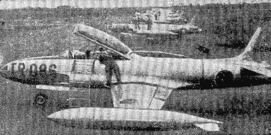 JASDF Lockheed T-33 jet trainers in 1955
JASDF Lockheed T-33 jet trainers in 1955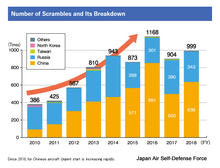 Number of scrambles and its breakdown of the JASDF (2010 - 2018)
Number of scrambles and its breakdown of the JASDF (2010 - 2018)
Organization
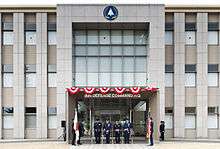
Major units of the JASDF are the Air Defense Command, Air Support Command, Air Training Command, Air Development and Test Command, and Air Materiel Command. The Air Support Command is responsible for direct support of operational forces in rescue, transportation, control, weather monitoring and inspection. The Air Training Command is responsible for basic flying and technical training. The Air Development and Test Command, in addition to overseeing equipment research and development, is also responsible for research and development in such areas as flight medicine. On May 19, 2020 the JASDF officially inaugurated its Space Operation Squadron.[15]
.jpg)
The Air Defense Command has northern, central, and western regional headquarters located at Misawa, Iruma, and Kasuga, respectively and the Southwestern Composite Air Division based at Naha, Okinawa Prefecture. All four regional headquarters control surface-to-air missile units of both the JASDF and the JGSDF located in their respective areas.
- Prime Minister of Japan
- Minister of Defense
- JASDF Chief of Staff / Air Staff Office
- Air Defense Command: Yokota, Fussa, Tokyo
- Northern Air Defense Force: Misawa, Aomori
- 2nd Air Wing (Chitose Air Base: 201SQ, F-15J/DJ, T-4; 203SQ, F-15J/DJ, T-4)
- 3rd Air Wing (Misawa Air Base: 3SQ, F-2A/B T-4; 302SQ, F-35A, T-4)
- Northern Air Command Support Flight, (Misawa, T-4)
- Northern Aircraft Control & Warning Wing
- 3rd Air Defense Missile Group
- 6th Air Defense Missile Group
- Central Air Defense Force: Iruma, Saitama
- 6th Air Wing (Komatsu Air Base: 303SQ, F-15J/DJ, T-4; 306SQ, F-15J/DJ, T-4)
- 7th Air Wing (Hyakuri Air Base: 301SQ, F-4EJ Kai, T-4)
- Central Air Command Support Squadron (Iruma Air Base T-4, U-4)
- Central Aircraft Control & Warning Wing
- 1st Air Defense Missile Group
- 4th Air Defense Missile Group
- Iwo Jima Air Base Group
- Western Air Defense Force: Kasuga, Fukuoka
- 5th Air Wing (Nyutabaru Air Base: 305SQ, F-15J/DJ, T-4)
- 8th Air Wing (Tsuiki Air Base: 6SQ, F-2A/B, T-4; 8SQ, F-2A/B, T-4)
- Western Air Command Support Squadron, (Kasuga, T-4)
.jpg) F-2B
F-2B - Western Aircraft Control & Warning Wing
- 2nd Air Defense Missile Group
- Southwestern Air Defense Force: Naha, Okinawa
- 9th Air Wing (Naha Air Base: 204SQ, F-15J/DJ, T-4; 304SQ, F-15J/DJ, T-4
- Southwestern Air Command Support Squadron, T-4)
- Southwestern Aircraft Control & Warning Wing
- 5th Air Defense Missile Group
- Airborne Early Warning Group: Hamamatsu Air Base (602SQ, E-767)
- Air Tactics Development Wing (Yokota Air Base)
- Tactical Fighter Training Group: Komatsu Air Base (F-15DJ/J, T-4)
- Electronic Warfare Squadron Iruma Air Base (EC-1, YS-11EB)
- Electronic Intelligence Squadron Iruma Air Base (YS-11EB)
- Air Rescue Wing
- Detachments: Chitose, Matsushima, Ashiya, Akita, Hyakuri, Nyutabaru, Niigata, Hamamatsu, Naha, Komatsu, Komaki (Training Squadron) (UH-60J, U-125A)
- Helicopter Airlift Squadrons: Iruma (CH-47J (LR)), Kasuga (CH-47J (LR)), Misawa (CH-47J (LR)), Naha (CH-47J (LR))
- Air Defense Missile Training Group: Hamamatsu, Chitose
- Northern Air Defense Force: Misawa, Aomori
- Air Defense Command: Yokota, Fussa, Tokyo
- Air Support Command: Fuchū Air Base, Tokyo
.jpg) A U-125A aircraft
A U-125A aircraft- 1st Tactical Airlift Group (Komaki Air Base: 401SQ, C-130H, KC-130H; 404SQ, KC-767)
- 2nd Tactical Airlift Group (Iruma Air Base: 402SQ, C-1, U-4)
- 3rd Tactical Airlift Group (Miho Air Base: 403SQ, C-1, C-2; 41SQ, T-400)
- Air Traffic Control Service Group
- Air Weather Group
- Space Operations Squadron
- Flight Check Squadron (Iruma Air Base: U-125,YS-11FC)
- Special Airlift Group: (701SQ Chitose Air Base: B747-47C as Japanese Air Force One)
- Air Training Command: Hamamatsu, Shizuoka
- 1st Air Wing (Hamamatsu Air Base: 31SQ, T-4; 32SQ, T-4)
- 4th Air Wing (Matsushima Air Field: F-2B; 11SQ, T-4 Blue Impulse 21SQ)
- 11th Flying Training Wing (Shizuhama Air Base: 1SQ, T-7; 2SQ, T-7)
- 12th Flight Training Wing (Hofu kita Air Base: 1SQ, T-7; 2SQ, T-7)
- 13th Flight Training Wing (Ashiya Air Base: 1SQ, T-4; 2SQ, T-4)
- Fighter Training Group (Nyutabaru Air Base: 23SQ (Ex-202SQ), F-15DJ, T-4)
- 1st, 2nd, 3rd, 4th & 5th Technical School
- Air Basic Training Wing
- Air Training Aids Group
- Air Officer Candidate School
- Air Development and Test Command: Iruma Air Base, Saitama
- Air Development and Test Wing (Gifu Air Base: F-15J/DJ, F-2A/B, C-1FTB, C-2, F-4EJ, F-4EJ Kai, T-7, T-4)
- Electronics Development and Test Group
- Aeromedical Laboratory
- Air Material Command: Jujou, Tokyo
- 1st, 2nd, 3rd & 4th Air Depot
- Air Staff College
- Air Communications and Systems Wing
- Aerosafety Service Group
- Central Air Base Group
- Others
- JASDF Chief of Staff / Air Staff Office
- Minister of Defense
JASDF Flag

The Japan Air Self-Defense Force flag was first adopted in 1955 after the JASDF was created in 1954. It is based on a cap badge made in 1954. The flag is cobalt blue with a gold winged eagle on top of a combined star, the moon, the Hinomaru sun disc and clouds.[16][17] The latest version of the JASDF flag was re-adopted on 19 March 2001.[18] The JASDF flag is different from the JSDF flag and the JGSDF flag. It is determined by a directive regarding the flags of the JSDF.
Ranks
Officers(幹部)
| NATO code | OF-9 | OF-8 | OF-7 | OF-5 | OF-4 | OF-3 | OF-2 | OF-1 | |
|---|---|---|---|---|---|---|---|---|---|
| Rank | 空将 (統合幕僚長および航空幕僚長) | 空将 | 空将補 | 1等空佐 | 2等空佐 | 3等空佐 | 1等空尉 | 2等空尉 | 3等空尉 |
| English translation | General | Lieutenant general | Major general | Colonel | Lieutenant colonel | Major | Captain | First lieutenant | Second lieutenant |
| Insignia Type A (甲階級章) |
.svg.png) | .svg.png) | .svg.png) |
.svg.png) | .svg.png) | .svg.png) |
.svg.png) | .svg.png) | .svg.png) |
| Insignia Type B (乙階級章) |
.svg.png) | .svg.png) | .svg.png) |
.svg.png) | .svg.png) | .svg.png) |
.svg.png) | .svg.png) | .svg.png) |
| Insignia Miniature Type (略章) |
.svg.png) | .svg.png) | .svg.png) |
.svg.png) | .svg.png) | .svg.png) |
.svg.png) | .svg.png) | .svg.png) |
Warrant Officer and Enlisted(准尉および曹士)
| NATO code | OR-9 | OR-8 | OR-7 | OR-6 | OR-5 | OR-3 | OR-2 | OR-1 | OR-D |
|---|---|---|---|---|---|---|---|---|---|
| Rank | 准空尉 | 空曹長 | 1等空曹 | 2等空曹 | 3等空曹 | 空士長 | 1等空士 | 2等空士 | 自衛官候補生 |
| English translation | Warrant officer | Senior master sergeant | Master sergeant | Technical sergeant | Staff sergeant | Airman 1st class | Airman 2nd class | Airman 3rd class | Self defense official cadet |
| Insignia Type A (甲階級章) |
.svg.png) | .svg.png) | .svg.png) | .svg.png) | .svg.png) |
.svg.png) | .svg.png) | ||
| Insignia Type B (乙階級章) |
.svg.png) | .svg.png) | .svg.png) | .svg.png) | .svg.png) |
.svg.png) | .svg.png) | .svg.png) | .svg.png) |
| Insignia Miniature Type (略章) |
.svg.png) | .svg.png) | .svg.png) | .svg.png) | .svg.png) |
.svg.png) | .svg.png) | No insignia |
Equipment
The JASDF maintains an integrated network of radar installations and air defense direction centers throughout the country known as the Basic Air Defense Ground Environment. In the late 1980s, the system was modernized and augmented with E-2C Hawkeye airborne early warning aircraft. The nation relies on fighter-interceptor aircraft and surface-to-air missiles to intercept hostile aircraft. Both of these systems were improved from the beginning of the late 1980s. Outmoded aircraft were replaced in the early 1990s with more sophisticated models, and Nike-J missiles have been replaced with the modern Patriot PAC-2 and PAC-3 system. The JASDF also provides air support for ground and sea operations of the JGSDF and the JMSDF and air defense for bases of all the forces. Base defenses were upgraded in the late 1980s with new surface-to-air missiles, modern antiaircraft artillery and new fixed and mobile aircraft shelters.
Aircraft
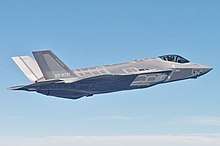
.jpg)
.jpg)
| Aircraft | Origin | Type | Variant | In service | Notes | |
|---|---|---|---|---|---|---|
| Combat Aircraft | ||||||
| Mitsubishi F-2 | Japan | multirole | 62[19] | based on the Lockheed Martin F-16 | ||
| F-4 Phantom II | United States | multirole | F-4EJ | 34[19] | ||
| Mitsubishi F-15J | Japan | air superiority | 155[20] | manufactured by Mitsubishi Heavy Industries | ||
| F-35 Lightning II | United States | multirole | F-35A, F-35B | 17 [21] | 142 F-35As on order with a further 42 F-35Bs.[22] | |
| AWACS | ||||||
| Boeing E-767 | United States | early warning and control | 4[19] | |||
| E-2 Hawkeye | United States | AEW | E-2C/D | 14 | 12 on order[19] | |
| Electronic Warfare | ||||||
| Kawasaki C-1 | Japan | electronic warfare | 1[19] | |||
| NAMC YS-11 | Japan | electronic warfare | 4[19] | |||
| Tanker | ||||||
| Boeing KC-767 | United States | aerial refueling / transport | 4[19] | |||
| KC-46 Pegasus | United States | aerial refueling / transport | 3 on order[19] | |||
| Lockheed Martin KC-130 | United States | aerial refueling | KC-130H | 2[19] | ||
| Transport | ||||||
| Boeing 777 | United States | VIP | 777-300ER | 2[23] | call sign Japanese Air Force One | |
| Hawker 800 | United Kingdom | SAR / transport | U-125A | 27[19] | ||
| Kawasaki C-1 | Japan | transport | 16[19] | |||
| Kawasaki C-2 | Japan | heavy transport | 8 | 12 on order[19] | ||
| C-130 Hercules | United States | transport | C-130H | 2[19] | ||
| NAMC YS-11 | Japan | transport / flight inspection[24] | 2[19] | |||
| Gulfstream IV | United States | transport / flight inspection[25] | United Kingdom | 5[19] | ||
| British Aerospace 125[26] | United Kingdom | transport / flight inspection | 2 | |||
| Cessna Citation Latitude | United States | transport / flight inspection | 2[27] | 1 on order | ||
| Helicopters | ||||||
| CH-47 Chinook | United States | transport / utility | CH-47J | 17[19] | licensed built by Kawasaki Heavy Industries | |
| Sikorsky UH-60 | United States | utility / SAR[25] | UH-60J | 50[19] | licensed built by Mitsubishi | |
| Trainer Aircraft | ||||||
| Mitsubishi F-15J | Japan | conversion trainer | F-15DJ | 45[19] | manufactured by Mitsubishi Heavy Industries | |
| Hawker 400 | United States | jet trainer | T-1 Jayhawk | 13[19] | ||
| Mitsubishi F-2 | Japan | conversion trainer | F-2B | 26[19] | ||
| Kawasaki T-4 | Japan | jet trainer | 200[19] | |||
See also
- Fighter units of the Japan Air Self-Defense Force
- Japan Maritime Self-Defense Force aviation
- Military ranks and insignia of the Japan Self-Defense Forces
References
- "What is JASDF?|ORGANIZATION | [JASDF] Japan Air Self-Defense Force". www.mod.go.jp. Archived from the original on 2015-03-17. Retrieved 2015-02-04.
- Gao, Charlie (19 February 2018). "Japan's Air Force: The Best in Asia?". Archived from the original on 30 May 2018. Retrieved 29 May 2018.
-

- "World Air Forces 2014". Archived 2013-12-25 at the Wayback Machine Flightglobal.com
- Koji, Miyake (5 February 2020). "Singapore Airshow 2020: Japan to form an 'aerospace' force".
- Takei, Tomohisa (2008). "Japan Maritime Self Defense Force in the New Maritime Era" (PDF). Hatou. Hatou. 34: 3. Archived from the original (pdf) on 15 December 2018.CS1 maint: ref=harv (link)
- 武居智久 (2008). 海洋新時代における海上自衛隊 [Japan Maritime Self Defense Force in the New Maritime Era] (PDF). 波涛 (in Japanese). 波涛編集委員会. 34: 5. Archived from the original (pdf) on 15 December 2018.CS1 maint: ref=harv (link)
- Associated Press, "Jap Air Force Will Get 85 U. S. Planes", Pittsburgh Post-Gazette (Pittsburgh, Pennsylvania), 7 January 1955, Volume 28, Number 137, page 2.
- "First Japanese woman to fly fighter jet". BBC News. 2018-08-24. Archived from the original on 2018-08-24. Retrieved 2018-08-24.
- "Airspace Surrounding Japan". Japan Ministry of Defense. 26 August 2018. Archived from the original on 26 August 2018. Retrieved 28 October 2019.
- "Russian bombers violated Japan's airspace twice in one day, defense ministry says". Stars and Stripes. 2019-06-21. Archived from the original on 2019-06-22. Retrieved 2019-06-23.
- https://edition.cnn.com/2018/12/18/asia/japan-aircraft-carriers-intl/index.html
- https://www.navalnews.com/naval-news/2019/08/usmc-to-first-fly-f-35b-from-japans-izumo-class-aircraft-carriers/
- https://www.rt.com/news/446747-japan-first-aircraft-carriers/
- "Japan sets up its first 'Space Operations Squadron'". Jane's. 18 May 2020. Retrieved 20 May 2020.
- 自衛隊の旗に関する訓令
- 桜星の数はかつての陸上自衛隊と同様、階級ではなく部隊規模を示していた。
- "Air Self Defense Force (Japan) |publisher=CRW Flags". www.crwflags.com. Archived from the original on 2016-03-15. Retrieved 2019-10-26.
- "World Air Forces 2020". Flightglobal Insight. 2020. Retrieved 10 March 2020.
- "Japan Receives 1st F-35 Joint Strike Fighter". thediplomat.com. Retrieved 19 March 2017.
- "Dutch Aviation Societ". Defense Security Cooperation Agency. Retrieved 8 August 2020.
- "JAPAN – F-35 JOINT STRIKE FIGHTER AIRCRAFT". Defense Security Cooperation Agency. Retrieved 8 August 2020.
- "Japan's New Air Force One". AirForces Monthly. Key Publishing. June 2019. p. 24.
- "YS-11FC". Japan Air Self Defense Force (in Japanese). Retrieved 16 May 2020.
- "U-4" (in Japanese). Retrieved 16 May 2020.
- "U-125". Japan Air Self Defense Force (in Japanese). Retrieved 16 May 2020.
- "Textron delivers first two U-680As to JASDF". Key Aero. 24 April 2020. Retrieved 16 May 2020.
External links
| Wikimedia Commons has media related to Japan Air Self-Defense Force. |
